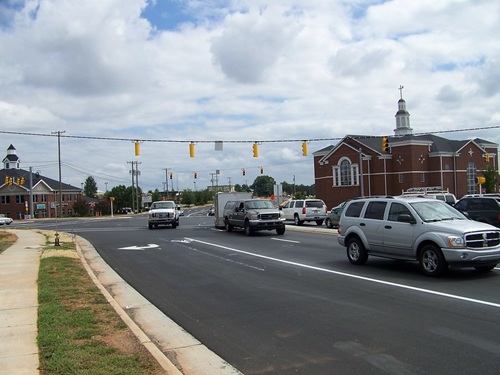A session held at the 2024 Transportation Research Board’s Annual Meeting in Washington, D.C., examined the ongoing development of the “Moonshot Project” by state departments of transportation across the country.
[Above photo by AASHTO]
Established in 2021 and approved to move forward by the American Association of State Highway and Transportation Officials in October 2022, the “Moonshot Project” is an effort to draft a “cohesive national transportation vision” for the United States.
Spearheaded by Julie Lorenz, the former secretary of the Kansas Department of Transportation, this project seeks to establish a national “framework” wherein state DOTs can work “collectively and individually” to develop an over-arching vision for addressing the country’s mobility needs of the future.

“It’s called the ‘Moonshot Project’ because we seek to harness similar ‘aspirational energies’ like the ones that infused the effort to put a man on the moon,” explained Carlos Braceras, executive director of the Utah Department of Transportation and a former AASHTO president, who moderated this session at TRB.
“The ‘Moonshot’ is about restoring national confidence in the benefits transportation provides,” he said. “We’ve engaged with a wide range of partners in this effort – speaking with groups that traditionally we’ve not spoken with before. That, at times, has been uncomfortable, yet in the end it has been really helpful for our work here.”
Nancy Daubenberger, commissioner of the Minnesota Department of Transportation, said her agency’s contribution to this project has been looking at ways to electrify and decarbonize her state’s mobility network – forcing her agency into the role of an electric power provider, which she said “is not the typical role for state DOT.”
Minnesota DOT continues to build on research conducted via its NextGen Highways Feasibility Study, examining strategies for “co-locating” electric and communications infrastructure in highway right-of-ways or ROWs.
That study focused on the potential deployment of buried, high-voltage/direct current or HVDC transmission lines within Minnesota interstate and highway ROWs – an effort that offers broader implications for highway ROW strategies in other states.

In a similar vein, Brad Wieferich – director of the Michigan Department of Transportation – is working ROW-based recharging systems for electric vehicles, including solar arrays.
“There is a lot that has to go into developing this – from the initial project siting phase, followed by the system implementation phase,” he said. “We are clearly aware there are states ahead of us on these projects – and I look forward to learning from them. The partnerships for this project, especially for non-traditional partners, is a new thing for us. We are working with [power] utility companies at a completely different level.”
He also noted that his agency is working to create a “one stop shop” to handle mobility and other related needs of the working poor; so-called “ALICE” workers and their families.
Wieferich explained that “ALICE” stands for “Asset Limited, Income Constrained, Employed” and seeks to identify the “mismatch” between low-paying jobs and the cost of survival, then develop solutions that promote financial stability at the local, state, and – eventually – the national level.
“When I think of the impact of what we have on people and the economy through transportation, it is immense – so we are trying to enhance accessibility and affordability for ‘ALICE’ folks by centralizing all the things they will need transportation-wise in one place,” he said. “There are sources of funds out there to pay for transit to medical services, for transportation to job opportunities – and our intention is to seek them out and bring together in one place.”
Meanwhile, Tracy Larkin Thomason – director of the Nevada Department of Transportation – is leading an effort to create a “connected corridor” along I-80 not only in her state but with subsequent states all the way to the U.S. East Coast.
“It truly believe transportation is fundamental to our way of life,” she explained. “So once we have the full backbone of this effort in place, there will be tremendous secondary benefits for first responders, law enforcement, and others.”
The key to the “Moonshot Project,” to her mind, is that it will allow each state to proceed at its own speed with such “transformative” research efforts.
“Every state has different priorities – and one of the things the ‘Moonshot Project’ could do is lay out a roadmap; an agreement that lets each state move at its own pace,” Larkin Thomason said. “Because the [transportation] funding decisions in my state are based on the priorities of my state.”
Meanwhile, Marc Williams – executive director of the Texas Department of Transportation – said his agency is using the “Moonshot Project” to help develop an autonomous trucking corridor between the cities of Houston and Dallas for freight deliveries.
“We are not just focused on the autonomous trucking side of this project but on the broader trucking industry as well,” he said, “We are working on pushing in-cab notifications to [truck] operators to make them aware of [roadway] events and conditions to improve their safety and efficiency.”
Williams said one key to the overall “Moonshot Project” effort is to identify “common needs and common goals” not just at the state DOT level but nationally, with the private sector involved as well.
“It is about having a future vision and figuring out how to sustain it – that is critical,” he said. “We can launch initial pilot project – but to fulfill the vision down the road requires sustained output by both government and private industry. As we begin to frame this up, we need to have a vision of where we will go in the future – one that has collaborative structure. That way we come up with a model to deploy and sustain connected infrastructure systems first across Texas, and then across the nation.”
 Top Stories
Top Stories


